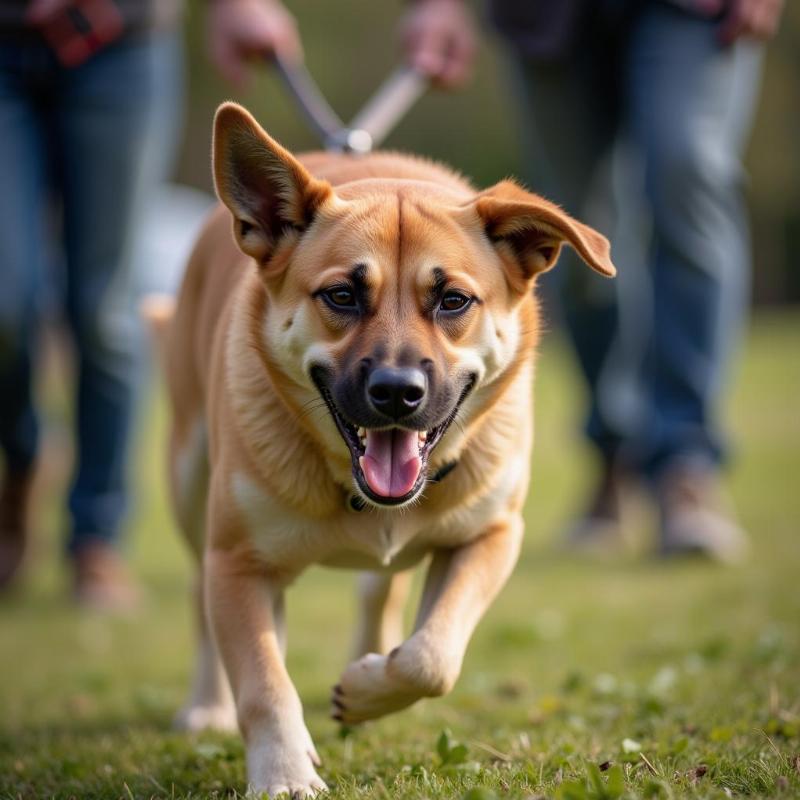If your furry friend transforms into a furry fury when encountering strangers on your daily strolls, you’re not alone. Many dog owners in the US grapple with the challenge of a dog who lunges at strangers on walks. This behavior, while frustrating, is often rooted in fear, anxiety, or territorial instincts. Understanding the reasons behind your dog’s lunging is the first step toward transforming those tense walks into enjoyable outings for both of you. This guide will offer practical tips and strategies to address this common issue and foster a calmer, more confident canine companion.
Why Does My Dog Lunge at Strangers?
Several factors can contribute to lunging behavior. Fear is a primary motivator, especially in dogs who haven’t been properly socialized or have had negative experiences with strangers. Anxiety, often triggered by unfamiliar sights, sounds, or smells, can also manifest as lunging. Some dogs lunge out of a protective instinct, guarding their owner or territory. Finally, excitement or frustration, especially in energetic breeds, can sometimes be misconstrued as aggression.
 Dog Lunging at Stranger on Leash
Dog Lunging at Stranger on Leash
Addressing the Lunging Behavior
The key to curbing lunging lies in consistent training and management. Start by identifying your dog’s triggers. Is it specific types of people, objects, or situations that elicit the lunging? Once you know the triggers, you can begin desensitization and counter-conditioning. This involves gradually exposing your dog to the trigger at a safe distance while rewarding calm behavior with treats and praise.
Training Techniques to Stop Lunging
Several training techniques can help manage and ultimately eliminate lunging. “Look at me” training, where you teach your dog to make eye contact with you on command, can redirect their attention away from the trigger. Positive reinforcement methods, such as rewarding desired behaviors, are crucial. Avoid punishment, as this can exacerbate fear and anxiety. Consult with a certified professional dog trainer for personalized guidance.
Tools and Resources for Leash Reactivity
Certain tools can assist in managing lunging behavior. A front-clip harness can gently redirect your dog’s pull, while a head halter can provide more control. Avoid retractable leashes, as these can actually encourage pulling. Consider using a calming aid, such as a pheromone spray or collar, in consultation with your veterinarian.
Finding a Certified Professional Dog Trainer
A certified professional dog trainer can provide invaluable support. They can assess your dog’s behavior, tailor a training plan to your specific needs, and offer guidance on management techniques. Look for a trainer who uses positive reinforcement methods and has experience with leash reactivity.
Conclusion
Addressing your dog’s lunging behavior requires patience, consistency, and a positive approach. By understanding the underlying causes, implementing effective training techniques, and utilizing appropriate tools, you can transform your walks from stressful ordeals into enjoyable bonding experiences. Remember that seeking professional guidance from a certified dog trainer or behaviorist can significantly accelerate your progress. With dedication and the right approach, you and your dog can conquer leash reactivity and enjoy peaceful, confident strolls together.
FAQ
- Why does my dog suddenly lunge at strangers? Sudden changes in behavior can be triggered by various factors, including fear, anxiety, pain, or a past negative experience.
- Is it ever okay to punish my dog for lunging? Punishment is generally counterproductive and can worsen the behavior. Focus on positive reinforcement and redirection.
- How do I find a good dog trainer for leash reactivity? Look for certified professional dog trainers who use positive reinforcement methods and have experience with leash reactivity. Ask for referrals from your veterinarian or local dog training facilities.
- What kind of equipment can help with lunging? A front-clip harness, head halter, and short leash can be helpful. Avoid retractable leashes.
- How long does it take to train a dog to stop lunging? The timeframe varies depending on the dog’s temperament, history, and consistency of training.
- Can medication help with leash reactivity? In some cases, medication may be recommended in conjunction with behavior modification. Consult with your veterinarian.
- What if my dog lunges and bites someone? Seek immediate veterinary attention for the injured person and consult with a veterinary behaviorist or certified applied animal behaviorist.
Beautdogs.us is your trusted companion in navigating the world of dog ownership in the US. We offer expert advice on dog care, breed information, training tips, and product recommendations. Whether you’re a seasoned dog owner or just starting your journey with a furry friend, Beautdogs.us is your go-to resource for comprehensive, engaging, and reliable information. For personalized advice or questions, reach out to our team at [email protected] or call us at +1 501-555-7529.